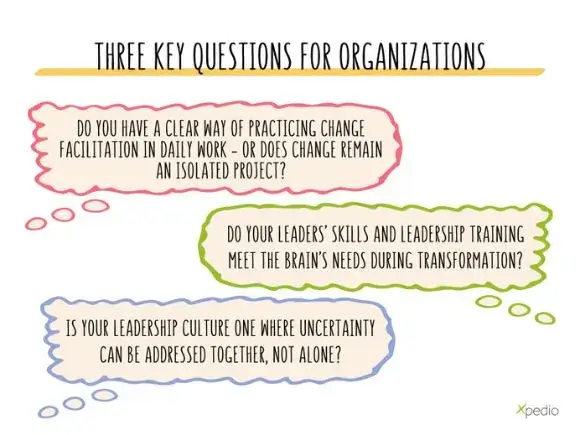Scroll to top
A change facilitator is a brain facilitator: How to lead transformation successfully
Change is a constant state in organizations. Workplaces no longer operate in a stable environment where a strategy can be defined for years ahead and then implemented step by step. Instead, strategy work is continuous, the business environment shifts rapidly, and teams must adapt at high speed. This puts new demands on change leadership and highlights the critical role of change facilitation.
Neuroscientist and change expert Hilary Scarlett has written extensively about how the brain responds to change. According to her, uncertainty triggers a stress reaction in the brain, narrowing thinking and making collaboration more difficult. Even when an organization needs creativity, courage, and decision-making ability, these very capacities weaken if change is not facilitated on the level of human experience. This explains why so many transformation projects fail: the technical plan may be sound, but people do not feel heard or understood.
What do brains really need in times of change?
Scarlett’s research highlights that, from the brain’s perspective, successful change leadership depends on three core elements:
- Clarity: People need information, but above all, they need to understand what it means for their own work.
- Involvement: When people feel they can influence outcomes, the sense of threat decreases, and commitment grows.
- Meaning: The brain responds positively when work is linked to values and a greater purpose.
If these needs are not addressed, the brain fills the gaps with negative interpretations. Without facilitation and dialogue, employees may feel excluded, lose their sense of control, and disengage.
Embedding change leadership into everyday work
Traditionally, change leadership has been seen as a project: define the goal, create the plan, and execute it. But this logic no longer works when change is constant. Organizations that continue to approach transformation as “one big project” are likely to fall behind.
What is needed is a new leadership culture where change is integrated into daily work. Managers can no longer be just supervisors of targets or approvers of reports. They must become meaning-makers, dialogue enablers, and effective facilitators. Their role is not only to announce what happens next but to facilitate spaces where people can process uncertainty and find their role in the journey.
Three key questions for organizations:
- Do you have a clear way of practicing change facilitation in daily work – or does change remain an isolated project?
- Do your leaders’ skills and leadership training meet the brain’s needs during transformation?
- Is your leadership culture one where uncertainty can be addressed together, not alone?

Change facilitation
The success of change never rests solely on individuals. It requires whole teams that can work effectively even under uncertainty. This calls for intentional team development that fosters psychological safety and open dialogue. Teams that can ask tough questions and challenge assumptions are the ones that thrive in continuous change.
Here, facilitation is a key method. When a facilitator helps a team hold the right conversations, set goals, and learn together, change becomes a shared journey instead of an individual struggle.
At the same time, leadership training is evolving. Beyond setting direction and communicating clearly, leaders increasingly need facilitation skills. They must build trust, enable collaboration, and support their teams even when answers are incomplete. This is a profound cultural shift – but also essential for organizations that want not only to adapt but to continuously renew themselves.
In many organizations, strategy work remains at the top management level. On paper, the strategy may look clear, but if it is not facilitated into daily practice, it remains a disconnected document. Here, participation is crucial: an inclusive leader translates abstract goals into everyday language and ensures every team member understands how their work contributes to the whole.
When strategy becomes dialogue and shared understanding, it is no longer just a message from leadership. It becomes the story of the entire organization – and that is when transformation takes root.
Conclusion
At Xpedio, we see every day that successful transformation is not just a process but a human experience. We help organizations strengthen the skills of facilitators, managers, and teams so they can thrive in continuous change.
When change is understood through the lens of the brain and supported by skilled change facilitation, it is an opportunity to build a more resilient, adaptive, and meaningful working life.
About the author – Mirjami-Sipponen Damonte:
I’m a strategist, facilitator, and advisor helping organizations navigate complexity, lead with clarity, and design cultures that support both people and performance. Through Xpedio, I work internationally with leaders and teams who want to make change real, not just talk about it.
If this post sparked something for you or if your team is ready to reimagine how you lead, learn, or collaborate, I’d love to hear from you.
Let’s explore what your next chapter could look like.




